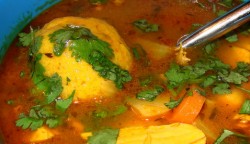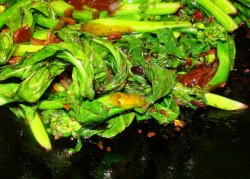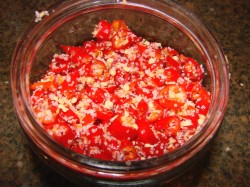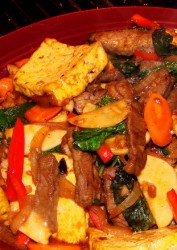The Shiksa’s At It Again: Sephardic Matzo Ball Soup
“Sephawhuh?” I am sure that thought is running through many folks’ minds when they read the title of this post, but be at peace, and let me explain a bit.
“Sephardic”, is a term which refers to Jews from Italy and the Iberian Peninsula–meaning Spain and Portugal. It is one of the designations of Jews which refers to the geographical homeland or origin, as well as to the liturgical style which they follow in worship. Other terms which describe groups of Jews which you may or may not have heard are “Ashkenazic,” which refers to Jews whose ancestry hails from Germany, Eastern Europe and the Baltic region, and “Mizrahi,” which refers to the Jews of the Middle East–technically, it means, “Eastern.” In the US, the terms used are usually Ashkenazic, meaning those of Eastern European ancestry, and Sephardic, meaning those from everywhere else, not just Iberia and Italy, with the term Mizrahi not used at all, which makes it all somewhat confusing. In Israel, all three terms are used–so some American Jews who have ties to Israel (or who are scholars or genealogists) may have heard the term Mizrahi, but it is not used commonly here at all.
More’s the pity it isn’t used, because it is more specific and correct a term to use than to lump every Jewish person of non-Eastern European descent under the term, “Sephardic.”
It is all very complicated, yes, and I am simplifying greatly, but I wanted to give some background here so that folks who were not Jewish could follow along a bit.
Most Jews in the US are Ashkenazic, though there are a few Sephardic Jewish folks scattered about here and there. And so, the food that most of us Americans think of as Jewish are foods that are typical of Eastern European cuisines–cabbage rolls, brisket, knishes, kugel, latkes, blintzes, and of course, matzo ball soup. The foods of the Sephardi and Mizrahi are different, filled with the flavors of the Mediterranean, North Africa, Yemen, and the Middle East; with a much more pronounced use of spices and a myriad of herbs. Examples of Sephardic or Mizrahic foods would be hummus or falafel.
On Monday, Zak had an uncomfortable stomach, and asked me for matzo ball soup, and while I was in the kitchen, I began to think about what it would taste like from a Sephardic or Mizrahi kitchen. This is because he is working on writing a story that features a character whose mother is an American Ashkenazic Jew and her father is Sephardic, and he had been asking me about what kinds of foods Sephardic Jews cooked and ate. I had been doing a bunch of research for him on the issue, and all of the cookbooks and recipes I had been reading had fired my imagination.
So, I decided to experiment with the idea, and added a few spices, some tomato, some pasta, and a some chickpeas–and surprisingly, came up with a very delicious version of matzo ball soup, even if it probably doesn’t exist anywhere in nature.
Matzo balls, as I mentioned before, are an Ashkenazic food; though I have read here and there that there are some Jewish families in Turkey who make them for special holidays. after I made this soup, I found a vegetarian Sephardic version, which interestingly contained all of the root vegetables I used in my own recipe. I used mine because we all like them, but, perhaps, they may be somewhat authentic after all.
They are simply made; you beat together two eggs, two tablespoons of olive oil and two tablespoons of chicken or vegetable stock. Then, you mix in 1/2 cup of matzo meal, and season it as you like with salt and pepper. I also added some ground cumin, smoked Spanish paprika, and some thyme.
You let your matzo mixture sit in the fridge uncovered for a half an hour–this lets the liquids soak into the matzo meal. While the batter sits, you bring a large pot of water to boil. Then, with oiled fingers, you shape the batter into balls the size of walnuts and drop them into the boiling water. At first, they sink, and then, in a few seconds, they bob to the top of the pot, where they dance among the bubbles and waves. After they are all in the pot, you cover it up, and let them cook for twenty or thirty minutes. If you let them cook for twenty minutes, you then transfer them to the simmering soup where you let them cook the final ten minutes. If you let them cook thirty, you just transfer them to the soup and serve it all right away. (I like to let them cook the last ten minutes into the soup, because they soak up some of the soup broth that way, and become quite flavorful and rich that way.)
Anyway, how did it all turn out?
Zak, Morganna, Dan and James all loved it, and hoped I would make it more often. The Aleppo pepper, along with the browned onions, garlic and spices, gave a really strong flavor base to the soup. The turmeric and tomato combined to give a robust color and flavor to the broth as well, and the chickpeas not only added a good flavor, but their round shape echoed the matzo balls. The pasta could have easily been overdone, but thanks to the fact that I had very little of it on hand, it wasn’t. Now that I know that I could easily have overwhelmed the soup with too much pasta, I will have a care in adding noodles or pasta to soups in the future.
The combination of cumin, coriander and cinnamon warmed the soup up considerably, giving it a lovely aroma that was warming not only to the body but the soul as well.
There are variations I would like to do–like add some diced canned tomato, and probably more chickpeas. I would definitely use orzo in the soup instead of the ditalini I had here to use, although I am curious about how it would taste with rice added to it as well.
At any rate, it turned out to be quite a tasty soup, rich with chunks of chicken, root vegetables and chickpeas, fragrant with onions, garlic, herbs and spices, with delicately flavored matzo balls floating among the garnish of fresh green herbs among the droplets of golden chicken fat.
You could conceivably make this soup in a crock pot, starting it in the morning or the night before, and having it ready for dinner. Then, all you would have to do is make the matzo balls. I made it in about an hour by using the pressure cooker. You could also cut down on the time involved by using only bone-in chicken breasts and thighs; these would cook faster, and would be easier to debone. Or, you could use already cooked and shredded chicken from another recipe, but your soup broth wouldn’t be as flavorful as the one made with a whole chicken.
Ingredients:
4 tablespoons olive oil
2 large onions, peeled and sliced thinly
1 teaspoon salt
1 tablespoon Aleppo pepper
2 stalks celery, diced finely
2 bay leaves
1 head garlic, peeled and minced
1 tablespoon dried thyme
1 teaspoon ground cumin
1 teaspoon turmeric
1/2 teaspoon ground coriander
1 1″ long cinnamon stick
1/2 cup dry sherry
1 whole chicken, rinsed and trimmed of excess fat
2 quarts of chicken broth or stock
1 quart vegetable broth or stock
3 tablespoons tomato paste or sauce
1 1/2 cups peeled and sliced carrots
1/4 cup peeled and sliced parsnips
1 cup peeled and diced turnips
1 15 ounce can chickpeas drained with any loose skins removed
1 14 ounce can diced tomatoes (optional)
1/2 cup orzo pasta, cooked, drained and oiled to keep from sticking.
1 recipe matzo balls (instructions given in the post above)
salt and freshly ground black pepper to taste
1/2 cup roughly chopped cilantro
1/2 cup roughly chopped fresh parsley
1/2 cup thinly sliced scallion tops
Method:
In a heavy soup pot or pressure cooker, heat olive oil over medium high heat. Add onions, salt and Aleppo pepper and cook, stirring, until golden. Add celery, bay leaves, garlic, thyme, cumin, turmeric, coriander and cinnamon stick, and cook, stirring until the onions are a rich reddish brown and everything is fragrant.
Pour in sherry and deglaze pan. After alcohol has burned off, add chicken, broths, tomato paste or sauce, and turn down heat to a simmer, and cook covered until the chicken is tender and done. In a pot it will be about an hour or an hour and a half, in a pressure cooker, it can be anywhere from fifteen minutes to a half an hour depending on the size of the chicken.
When the chicken is done, remove it from the pot and allow it to cool. While it is cooling, add carrots, parsnips and turnips to pot and simmer. Remove chicken meat from bones and add back to pot. Add chickpeas and tomatoes if you are using them. Cook until vegetables are tender. Remove bay leaves and cinnamon stick.
Add matzo balls for last ten minutes of cooking. Just before serving, add orzo, simmer a couple of minutes to warm the pasta, then garnish with the cilantro, parsley and scallion tops.
Serve with a crisp green salad with a simple vinaigrette.
Note: As Emily, a longtime reader, pointed out, Ashkenazic Jews traditionally serve matzo ball soup at Passover. During that holiday, families who keep kosher, meaning, they follow the laws of Kashrut which involve what foods to eat, and how to eat them, do not eat either noodles or legumes. Sephardic Jews, on the other hand, do eat legumes at Passover.
So, do understand that this soup I did not mean as a Passover dish, but rather a soothing, comforting soup for any day except Passover. And then, if it was for Passover, what was in it would depend upon the traditions of the household for which it was being cooked.
Good Greens: Gai Lan With Hunan Salted Chilies and Ground Bean Sauce
The seasons shift; a veil of mist shrouds the hills surrounding Athens, and the multi-hued leaves whisper, wafting to the newly damp ground in fluttering waves of amber, gold, russet and brown. The winds have grown chill with autumn’s first frost, and most of the plants which grew summer’s tender fruits, vegetables and herbs have died back, their stalks shriveling, their leaves yellowing and wrinkling like ancient parchment. At the farmers’ market last weekend, I saw (and bought) some of the last sweet and hot peppers, tomatoes, eggplants, cucumbers, and bitter melons.
I traded three packets of gai lan seeds to the folks at Cowdery Farms for a handful of tiny, celadon green bitter melons on Saturday. I cooked the melons in my usual way, with chicken and fermented black beans, and they were delicious–crisp and both bitter and sweet. The gai lan, I will likely have to wait to taste until spring, though perhaps next fall there will be a second crop of it, sweet from the kiss of frost and long cold nights.
It will be nice to have locally grown gai lan, but until then, I buy it from the Asian market here in town; it is shipped in from California. Zak and Morganna and I love it so much, we refuse to give it up entirely. It is so versatile; I like it both steamed and stir fried, and it pairs beautifully with beef, tofu, chicken and pork, or it can be cooked to star in its own dish.
Its emerald green leaves can be slightly bitter, while the paler green stalks (which soften in shade to white on the inside) tend to be crisp and sweet. The flowerlets, when they appear, look much like broccoli in shape and color, but their flavor is more akin to kale. (Gai lan is often labeled in English as Chinese broccoli or Chinese kale, though, really, it is unique, and while similar to both of those vegetables, has its own flavor and texture profile.) The entire plant of gai lan is eaten, (except the roots) with preference shown to younger, thinner stalks and tenderer leaves on plants which have either not flowered at all, or which have barely set forth buds.
Sunday night, I decided to stir fry the gai lan I had to go with the Ma Po Tofu I was making. I could have done the typical, classic combination of gai lan with oyster sauce, but instead, I wanted something a little snazzier. Something with tang and bite and a scintillation of chile heat. I looked in my fridge and saw the Hunan salted chilies jar there, with the ground bean sauce right next to it and had an inspiration.
I took both of those jars out, along with the package of fermented black beans and got to cutting onion, garlic and ginger. From my pantry, I took the ever-present Shao Hsing wine and Chiangking Black Vinegar. (If you have neither of those sitting around, you can always use dry sherry and balsamic vinegar. No, really, you can. And you can use fresh chilies instead of the salted ones. But, you cannot replace the ground bean sauce–I am sorry. You will have to pick some up at the Asian market.)
The dish went together quickly and easily, and made a sharply flavored, savory, dark-sauced green to go with the tofu. The salted chilies are not only hot, but a bit sour and tangy because they are fermented, and the ground bean sauce has a deep, meaty savory flavor that is heavy in salt, but otherwise hard to describe. The fermented black beans add to that flavor, which is complemented by the aromatics–especially the onion and garlic. The wine gives depth to the sauce, while the vinegar, added at the last minute, boosts the already present tang from the chilies, and complements the slightly bitter gai lan leaves perfectly. (I grew up dressing kale and other greens with cider vinegar at the table, so I always associate greens and vinegar, so the two are inextricably entwined in my taste memory.)
I urge everyone to give this dish a try–I liked it even better than the classic combination of gai lan with oyster sauce. It is a totally vegetarian, actually, vegan recipe, so it can be enjoyed by everyone. It would go great with any tofu dish, or with a steamed or braised meat dish, too. I thought it was great for a blustery autumn night when the wind was blowing leaves in swarms and the cold rattled at our windowpanes, trying to seep into our nice warm house.
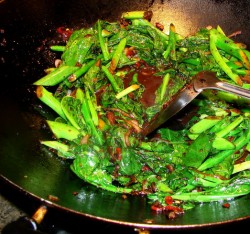
Gai Lan With Hunan Salted Chilies and Ground Bean Sauce
Ingredients:
3 tablespoons peanut or canola oil
1 medium onion, peeled and thinly sliced
1 tablespoon fermented black beans
4 large garlic cloves, minced
1 1″ cube fresh ginger, peeled and minced
1 tablespoon Hunan salted chilies, or fresh chilies, sliced thinly (or to taste)
3/4 pound fresh gai lan, washed, ends of stalks trimmed, and cut into bite sized pieces
1 tablespoon Shao Hsing wine or dry sherry
2 tablespoons ground bean sauce
1 tablespoon (or to taste) Chiangking black vinegar or balsamic vinegar
1/2 teaspoon toasted sesame seed oil
Method:
Heat wok over high heat until a thin ribbon of smoke spirals up from the bottom. Add oil, swirl to coat bottom and sides, and allow to heat up for about thirty seconds to a minute.
Add onion and black beans, and stir and fry until onions turn dark golden and go soft–about a minute and a half or two minutes. Add garlic, ginger and chilies and stir fry for about a minute or so more.
Add gai lan and the wine, and stir and fry until the leaves wilt and the stalks soften slightly–about three minutes. add the ground bean sauce, and stir to combine–if it is too sticky add either a tablespoon of water to the wok or another tablespoon of wine, to make a sauce that will coat the gai lan, but not clump up and be gross.
Remove from heat, and stir in vinegar and sesame oil until they are well combined, then serve immediately with steamed rice.
Note: If you cannot find gai lan, try this method with any kind of strongly flavored green–broccolini, broccoli rabe, kale, lacinato kale, mustard or collard greens, or plain old broccoli. They will all taste good this way, I promise. The more delicate greens, like bok choi, tatsoi, or napa will all be overpowered by the strong flavors of the sauce, so leave those for different preparations.
Michael Pollan On The Farm Bill
We all know what the Farm Bill is, don’t we?
Well, in case we don’t, Michael Pollan steps up to the plate and explains the history of it, the significance of it, and the particulars of the 2007 Farm Bill in his recent OpEd piece, “Weed It and Reap.” He notes in his well-reasoned essay that this year’s farm bill is different than those in the past, because this time around, Americans are actually paying attention to what is going into it and are making their feelings known about the issues of what they want on their plates.
Americans have begun to ask why the farm bill is subsidizing high-fructose corn syrup and hydrogenated oils at a time when rates of diabetes and obesity among children are soaring, or why the farm bill is underwriting factory farming (with subsidized grain) when feedlot wastes are polluting the countryside and, all too often, the meat supply. For the first time, the public health community has raised its voice in support of overturning farm policies that subsidize precisely the wrong kind of calories (added fat and added sugar), helping to make Twinkies cheaper than carrots and Coca-Cola competitive with water. Also for the first time, the international development community has weighed in on the debate, arguing that subsidized American exports are hobbling cotton farmers in Nigeria and corn farmers in Mexico.
This is a sign that Americans have begun waking up to the fact that our agricultural system is skewed toward corporate profit at the expense of the environment, small family farms, public health and diversity in food choices. However, public awareness is only half of the battle. The public not only has to be aware of the issues at hand in the formation of the farm bill, but also has to have some idea of -what to do- about what they want and need the farm bill to cover.
After noting that the 2007 version of the farm bill is as filled with corporate welfare as every other one in recent memory, with large subsidies once again going out to growers of large commodity crops–corn, soy, rice, wheat and cotton–which are used in the production of much of the fat and sugar-laden processed food which has been blamed for the obesity and related diabetes epidemic, Pollan asks how this could possibly happen, and then answers himself succinctly.
…farm bill critics did a far better job demonizing subsidies, and depicting commodity farmers as welfare queens, than they did proposing alternative — and politically appealing — forms of farm support. And then the farm lobby did what it has always done: bought off its critics with “programs.†For that reason “Americans who eat†can expect some nutritious crumbs from the farm bill, just enough to ensure that reform-minded legislators will hold their noses and support it.
It’s an old story: the “hunger lobby†gets its food stamps so long as the farm lobby can have its subsidies. Similar, if less lavish, terms are now being offered to the public health and environmental “interests†to get them on board. That’s why there’s more money in this farm bill for nutrition programs and, for the first time, about $2 billion to support “specialty crops†— farm-bill-speak for the kind of food people actually eat. (Since California grows most of the nation’s specialty crops, this was the price for the state delegation’s support. Cheap indeed!)
There’s also money for the environment: an additional $4 billion in the Senate bill to protect wetlands and grasslands and reward farmers for environmental stewardship, and billions in the House bill for environmental cleanup. There’s an important provision in both bills that will make it easier for schools to buy food from local farmers. And there’s money to promote farmers’ markets and otherwise support the local food movement.
But as important as these programs are, they are just programs — mere fleas on the elephant in the room. The name of that elephant is the commodity title, the all-important subsidy section of the bill. It dictates the rules of the entire food system. As long as the commodity title remains untouched, the way we eat will remain unchanged….
However many worthwhile programs get tacked onto the farm bill to buy off its critics, they won’t bring meaningful reform to the American food system until the subsidies are addressed — until the underlying rules of the food game are rewritten. This is a conversation that the Old Guard on the agriculture committees simply does not want to have, at least not with us.
What can be done about this big knotty mess of corporate agricultural interests tangled with typical bureaucratic unwillingness to embrace change which is crippling citizens’ ability to enact a change in the way in which our country eats for the better?
My feeling is that the more people who are able to opt out of the typical American diet of highly processed foods and fast foods, who do so, the better. We consumers can still vote with our pocketbooks, and if we can afford to, and have the choice, I think it behooves us to put more of our food dollars into the pockets of local farmers who produce food ethically and sustainably. The more of us who get off the corporate food merry-go-round the better, not only for ourselves, our local economy and our environment, but also for the good of our children’s futures.
Think about it. What kind of world are our kids going to inherit if they have Type II diabetes brought on by extremely unhealthy diets? How are they going to function in a world where the food supply is tainted with bacteria, chemicals and antibiotics because profit is valued more than food safety? What kind of land will they live on if much of the countryside is polluted with agricultural chemicals, with waterways and air equally poisoned?
Anyway, if you really care about food, read Pollan’s article, and then, if you feel so inclined, contact Senate Majority Leader Harry Reid with your concerns.
Homestyle Tofu, Beef and Autumn Vegetable Stir Fry
I know that I haven’t posted much about Chinese food recently. Bad, wicked Barbara! Shame on me!
It is mostly because I had posted so many recipes for Chinese noodles (and yes, I will go back to those eventually, I promise, promise, promise), then got distracted by all of the canning and food preserving, that I lost my way.
Wednesday night, after I came home from work early in the afternoon, I decided enough was enough. I wanted good Chinese food. I wanted a nice, homey stir fry with lots of veggies and tofu, dammit. And I had a small bit of top round beef that could go in as well to please Zak and Morganna, the more carnivorous pair in the household.
So that is what I bloody well did. I hauled off and started digging through my fridge to see what vegetable goodies I had from the farmers’ market. I came up with a crisp bunch of spicy mustard greens, curly-edged and fragrant, some sweet Japanese turnips, their white skins so smooth, they felt like polished alabaster, some carrots, and a sweet red bell pepper, probably my last local one for the year. I had fresh local tofu, but was out of fermented black beans, so I pulled a jar of Chili black bean paste I had been meaning to try from my pantry, to see what it was like. And that bit of beef was perfect to go with everything else, because there wasn’t enough of it to stand on its own, but its grassfed flavor–nice and strong and beefy, for want of a better word, would stand up to the assertive vegetable flavors while the texture would contrast with the crispy crust of the tofu.
I deep fried the tofu first–just because I felt like it–and let it drain thoroughly on paper towels. For a discussion of how to deep fry tofu, look at my version of Peng’s Home Style Beancurd from Fuchsia Dunlop. You can pan fry it instead, or bake it, or just skip this step.
And, by the way–if you don’t want meat in this–don’t put it in there. The dish is just fine without it. In fact, I only tasted one small strip of the beef to make sure it tasted good. The fried tofu and vegetables was heavenly on its own, so I think that you vegans out there could make a really, really nice Tofu and Autumn Vegetable Stir Fry and ignore the beef I put in it.
What did it taste like? Oh, I have to tell you that the combination of vegetables was just right. The mustard greens were spicy and velvety, while the turnips were just soft, and so sweet it was like eating root vegetable candy. The carrots were sweet, too, but more crisp, and the red pepper, which was the sweetest of all, was tender-crisp and both brilliant in color and flavor. These vegetables went perfectly well with the tofu and beef.
It was a good dinner, with steamed rice, of course, and my beloved pu er tea.
Homestyle Tofu, Beef and Autumn Vegetable Stir Fry
Ingredients:
5 ounces beef top sirloin or round, cut on the bias against the grain into thin slices
2 tablespoons dark soy sauce
1 teaspoon raw sugar
3 tablespoons cornstarch
1 tablespoon Shao Hsing wine or dry sherry
4 tablespoons peanut or canola oil
1 large yellow onion, thinly sliced
3 tablespoons ginger, minced
2 tablespoons garlic, minced
3 heaping teaspoons chili black bean sauce, or to taste
8 ounces extra firm tofu, cut into 1″X1″X1/2″ slices, deep fried and drained
2 teaspoons dark soy sauce
1 1/2 tablespoons Shao Hsing wine or dry sherry
1/4 cup carrot, peeled and thinly sliced on the bias
2 turnips, peeled and cut in half, then cut into thin half-moons
1/4 cup sweet red bell pepper, thinly sliced
1 1.2 cups mustard greens, large veins removed, rinsed, dried and cut into bite sized chunks
1/4 cup chicken, beef or vegetable stock
1/2 teaspoon toasted sesame oil
Method:
Toss beef with sugar, cornstarch, soy sauce and Shao Hsing, and allow to marinate for at least twenty minutes.
Heat wok on very high heat until it just begins to smoke. Add peanut or canola oil, and allow to heat for about thirty to forty seconds more. Add the onions, and stirring, allow to begin to brown–when they are light golden, add beef, and spread it into a single layer. Sprinkle the ginger and garlic over and allow the beef to sit undisturbed on the bottom of the wok for about a minute until it begins to brown, and you can smell a beefy aroma mixed with browning onions.
Add the chili black bean sauce and start stir frying vigorously, until most of the red is gone. Add the tofu and the soy sauce, stirring until both beef and tofu are coated with sauce. Deglaze the pan with the second measure of wine, and then toss in the carrots, stirring and frying for a minute. Add turnips, and sweet bell peppers and stir fry another minute. Add greens, and broth, and stir fry until the greens wilt and the broth thickens and clings to everything in the wok.
Remove from heat and drizzle with sesame oil, and serve immediately with steamed jasmine rice.
Feeds about four adults and a hungry infant.
Happy All-Hallows Eve and All Saint’s Day!
Today was my first day of work at Salaam, so that is why I am late wishing everyone a happy Halloween. By the time I got home, went to the grocery store to pick up candy for the trick or treaters, went on another errand, then got home, got together with Zak, Morganna and Kat to carve Jak, whom you see pictured above, and then made dinner and ate it, and then went back out to the grocery store to pick up the frozen waffles Morganna needed for an art project, it was already All Saint’s Day.
So, hence my late All Hallow’s Eve greeting.
It was a great day at work–it is good to be back in a restaurant kitchen. I am going to have fun making up dinner and lunch specials and putting them together. It will be nice to make stuff that I think would be great, but which are just not going to fly here at home because of limitations on what folks like. (Stuffed eggplant or squash–uh, no way, not here. At Salaam, though, such things are all to the good!)
The best part of the day, however, was carving Kat’s first pumpkin, named Jak. It was a very messy, very fun, family activity in which we all participated–even the cats.
When he was done, as you can see, Kat had to hug him.
This weekend, I will post more pictures of the action, but for now, I will leave you with these two images. Just to whet your appetite, so to speak.
Oh, and the lunch special today was none other than Moroccan Pumpkin Soup. Dennis made it, and it turned out fantastic–rich, smooth and filled with flavor. We garnished it with toasted fennel and nigella seeds, which added a texture, color and flavor contrast–the sweet fennel and oniony nigella were perfect with the rich, velvety smooth pumpkin soup.
I’ll have to copy down the recipe Dennis used and make it here–because I bet Kat would like it. She kept trying to eat bits of Jak–I think she thought he smelled good. Unfortunately, he didn’t taste nearly as good as that lovely soup. (Guess what I had for lunch!)
Powered by WordPress. Graphics by Zak Kramer.
Design update by Daniel Trout.
Entries and comments feeds.

